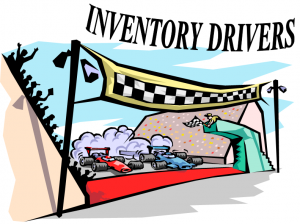 One of the biggest Inventory Drivers is Safety Stock. Safety Stock is, by definition, excess stock that you deliberately keep in order to insure higher Customer Service levels. (We will talk about Customer Service in a later posting.) There are many ways of calculating how much safety stock you need but the easiest is by calculating it based on the desired service level. The formula for this is:
One of the biggest Inventory Drivers is Safety Stock. Safety Stock is, by definition, excess stock that you deliberately keep in order to insure higher Customer Service levels. (We will talk about Customer Service in a later posting.) There are many ways of calculating how much safety stock you need but the easiest is by calculating it based on the desired service level. The formula for this is:
Safety Stock = Standard Deviation X Service Level Safety Factor
The problem with this is that as the desired service level goes up so does the required inventory but not in a linear form but rather as exponential growth. What this means is that, as a rule of thumb, for the last couple of percent increases in service level the required inventory will double. Specifically, if you need 1 million dollars’ worth of inventory for 97% service level, you will need about 2 million for 98%, 4 million for 99% and infinite inventory for 100%. So when upper management says you are never allowed to stock out, it is statistically impossible (no such thing as 100% only 99 with a whole bunch of 9’s after the decimal). The more important point is that no organization can afford to carry enough inventory to ensure they never stock out. Fortunately theory and reality rarely match exactly and there are a number of controls and expedite tools to get better service levels than mathematically projected. The larger point here is that most people (and ERP systems) just do the calculations and never question the answer. This can lead to much higher inventory levels than necessary. We need to control the inventory levels which means controlling the drivers (such as Safety Stock).
Regardless of the calculated number, one of the easiest ways to reduce it is to investigate the standard deviation of the demand and find ways to reduce it. This will automatically reduce the calculated safety stock levels. If your organization is already invested in Lean Six Sigma, this is a prime area for waste reduction and deviation control. Some of the other areas that will affect safety stock are:
- Inventory Accuracy levels

- Lead Time
- Demand Inconsistency
- Warehouse Capacity
- Production Capacity
- Service part commitments
- Shelf life
- Logistics (Inbound and Outbound)
- Government regulations
Another issue with safety stock is that once it has been set, many organizations fail to review the number on a regular basis (at least annually). For anyone using MRP this is critical because the system will automatically use the safety stock level quantity in the order point calculation. Let’s say that a material has been discontinued and all the stock sold off. If the safety stock level has not been reduced to zero then the system will automatically generate a new requisition to bring stock back up to at least the safety stock level. If there is a standard lot size embedded in the system then the generated requisition will be for that lot size. Unless someone notices that this is an obsoleted part it WILL be ordered and brought in, thereby creating excess / obsolete inventory. How good is your system and could this happen to you? Using Safety Time rather than safety stock will help avoid this problem because the level is set by the forecast rather than a fixed number. If there is no forecast in the system than the quantity will auto set to zero. This is also useful if you have a highly seasonal product as the safety stock quantity goes up and down in response to the forecast. Of course that solution does assume a relatively accurate and up to date forecast which is a whole different topic. (See my previous blog on Forecast Accuracy.)
The critical thing to remember in all this is that Safety Stock is all about balanced risk. You are balancing the cost and risk of obsolete or slow moving stock against the risk of shorting a customer order. Given the costs and repercussions of shorting a customer, most organizations will tend to keep a little more stock than necessary to ensure fewer stock outs. While not necessarily a bad thing it should not be carte blanche to let the inventory run wild. In the end inventory is just money in another form and no company can let their costs get out of control.
Enjoy thinking about this topic. Talk to your friends and co-workers about their experience and thoughts on this topic, especially what it means for your organization. I would love to hear back on your (and their) thoughts.

You must log in to post a comment.